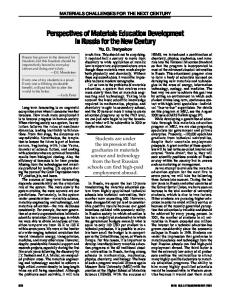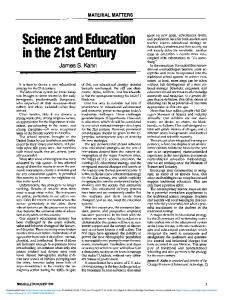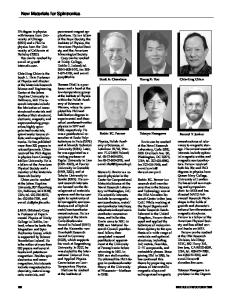Materials Education for the New Century
- PDF / 152,087 Bytes
- 7 Pages / 612 x 792 pts (letter) Page_size
- 34 Downloads / 393 Views
MATERIALS CHALLENGES FOR THE NEXT CENTURY
Materials Education for the New Century M.C. Flemings and S. Suresh Genius without education is like silver in the mine. —Benjamin Franklin, 1700s
Introduction Practitioners of materials science and engineering receive their education in a wide range of academic departments and programs. At the undergraduate level, it is taught in schools of engineering, in departments with purely materials titles (e.g., “Materials Science and Engineering [MSE],” “Metallurgy and Materials Science,” and “Ceramics”), and in departments in which materials is combined with another discipline (e.g., “Materials and Chemical Engineering”). Also included are materials programs and divisions housed in departments of other disciplines (e.g., “Mechanical Engineering”). At the graduate level, materials science and engineering is taught in the materials departments as just listed. It also comprises a part of the graduate program of most engineering departments, physics, chemistry, and now biology. We concern ourselves in this article primarily with those materials departments which have a broad materials focus and an undergraduate as well as graduate academic program leading to the doctorate. We outline something of the historical development of these departments and describe the evolution of two subfields of materials, as specific examples, to better illustrate the development over time of the MSE paradigm (i.e., structure, processing, properties, performance, and their interrelationships). We present our views on how the curricula and character of these departments will evolve in light of technological, industrial, and social trends, and on how the rapidly evolving distance-education technologies will affect them. This article amplifies and extends three previously published related articles.1–3
From Metallurgy to MSE in U.S. Universities Modern MSE departments initially evolved in the United States, mostly from older metallurgy departments, many of which had evolved in turn from mining departments. The materials departments at the University of Idaho and, until recently, of the University of California— Berkeley show this heritage with the retention of the words “mining” and 918
“mineral engineering,” respectively, in their titles. In the 1860s, precious metal and other nonferrous metal ore lodes were found in the Colorado and Utah Rocky Mountain region. By the 1880s, major iron ore deposits were being worked in Missouri and in the Lake Superior region. Extensive coal mining operations were under way in Pennsylvania. Additional major ore deposits continued to be discovered, and new mining companies formed, through the latter half of the 19th century. The demand for trained engineers to extract these ores and enrich them at or near the mine site was great.4 When the first engineering schools were formed, steelmaking was a fledgling industry, with less than 20,000 tons being produced annually in the United States. The Bessemer process was introduced to the United States in 1864, and then the open-h
Data Loading...











